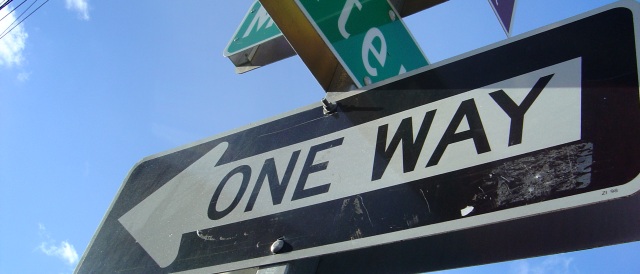Some energy companies and politicians argue that the choice is not between renewables and fossil fuels, but a question of compromise of holistic energy mix, sometimes framed as “all of the above” strategy. Kirsten Hasberg argues that this strategy is flawed.

You cannot take two contradictory energy strategies at once. (Photo by Rivertarts, CC BY-NC 2.0)
Picture this: You’re sitting in a meeting with people you disagree with. You’re tired, and it’s Friday afternoon. You just really want to get over with it. And since you can’t convince everybody, you’ll make this uncomfortable compromise: “Yes, we’ll take your idea, and we’ll take mine as well.” Both of you know that this is not particularly realistic, since the two options are mutually exclusive. Actually, they are substitutes to each other rather than complements. Also, you are actually competing for the same financial and time resources. Nevertheless, it makes a beautiful press release that once again, an agreement was reached. Meeting over. Phew. Same is true when talking about the energy revolution. First, we heard big energy companies say: “It’s a question of both – not either or” – this was their repeated argument, or cover-my-ass-strategy, because it includes big coal with CCS and nuclear as part of a “sustainable energy system”. So, beware when you hear the conventional wisdom of “we need all solutions”, now that you know how that board meeting must have looked where that decision was crafted…This is what a recent blogpost by John Farrell is about. And as he argues:
When talking clean energy policy, it may sound inclusive to suggest that “we can do both” big, centralized and small-scale, decentralized renewable energy development. But money for clean energy is zero-sum.
Farrel even uses my favorite words: Path dependency and “democratizing the energy system” – exactly my keywords! (I’ve written university reports on this topic, so I’ll leave path dependency and lock-in theory for a separate post…)
Farrell concludes (and I couldn’t say it any better):
…the focus on centralized generation infrastructure creates a path dependency that can limit opportunities for distributed generation development.
That’s a bad deal, especially when there are signs that smaller generation gets bigger numbers of renewable energy projects online, faster. If we care about the urgency of climate change, and desire the biggest bang for the renewable energy buck, we may have to choose a path.
This blog post was originally published on http://www.tumblr.com/blog/energydemocracy
Thanks for the great post! We’re been saying the same thing for years. Too many people in the US still believe, “we need both”, failing to see the inherent conflict. In addition to yielding more bang for the buck, DG avoids the need for costly new transmission, 5-15% transmission losses and massive environment impacts from remote, centralized wind and solar on undisturbed public lands. Unfortunately, in the US, utility companies are guaranteed full cost recovery and double digit returns on investments for building new transmission and generation. These “perverse” incentives drive industry/agency plans for massive new transmission, remote centralized renewables, and conversion to natural gas. I would love to see what you’ve written on this topic and look forward to hearing about path dependency and lock-in theory in future posts!
Hi Ceal,
You just made my blog post the first one on the Energytransition.de-blog with reader comments! Thanks for your interest! 🙂
It’s really a basic opportunity cost argument, of the kind you find in first year economics textbooks. Nevertheless, I’ve whitnessed how this clear dictonomy has been attempted covered up or masked repeatedly.
Perverse incentives (to all readers: This is not meant in an offensive way, this is actually a sober expression for an economist, and it has a well-defined texbook meaning) are unfortunately no rarity in Europe eighter, and giving priority to rolling out copper happens here, too.
I looked into path dependency, lock-in and institutional economics while studying economics at the University of Copenhagen. Fortunately, there’s also theory on how to escape the lock-in: Basically, it’s about creating market disruption through incentives. And that’s just what feed-in tariffs do.
Until a write a post about it, here’s one of my favourite authors on the topic: Gregory Unruh, who wrote “Escaping carbon lock-in”. Seems he’s caught up on social media presence and video, he’s talking about his topic in a video here: http://gregoryunruh.com/carbon-lock-in/
Talk soon again here!
Kirsten